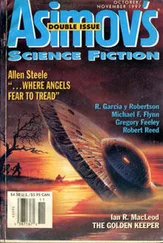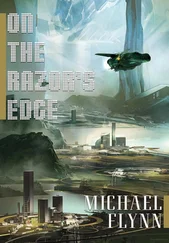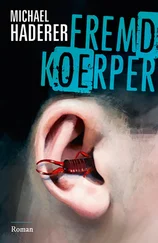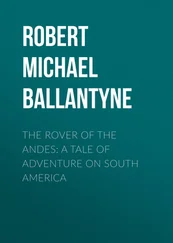While nearby stars were individual points of yellow and white and red and blue, they were no more than free particles thrown off by a great slurry: the Spiral Arm. In that great Core-ward swath of light, individual stars were lost, no more than bricks in a great white wall.
“The Orion Arm,” she said, pointing this out. “It’s like there is no Rift between us.”
“Oh, the Rift is real enough. From Ramage, you can see it clearly. But their ‘Orion Arm’ is only a part of our Perseus Arm split off by the Rift. Or so the Pedant tells me. This view… You get a sense of how small the League and the Confederation are. The vast majority of those stars out there have never shone on human folly.”
“‘It’s a big Spiral Arm.’ That’s what they always say. Oh, look! That bright star. The display says it’s Siggy Sun. It looks so far away. Yet, we’re in Siggy System.”
“Those stars,” he said, as if not hearing. “They are not only leagues away; they’re years ago. This is a vista of time, as well as space. Blind Rami, were he visible from this angle, would be Blind Rami two centuries ago. Jehovah, a millennium. They are not even contemporary. There are thriving worlds out there where, had we’ scope enough, we would see barren wastes, because this light, here, today, is from a time before they were even terraformed.”
They had begun their perambulation, slowly clockwise around the torus, as was the custom. Now and then, they stopped to activate a placard identifying this or that distant sight. The Crab Nebula, looking not much like a crab from this direction, hung off in the galactic west, just within the borders of the ULP.
Several large telescopes, called “Hummels,” were mounted to High Kaddo Station, and these fed special images to the faux-windows. By touching a spot, that portion of the skyscape would swell in magnification as the Hummels obediently redirected themselves. The Fudir summoned a close-up of the Crab.
“It’s as if we zoom out into the cosmos,” said the delighted harper. Then, “It’s quite beautiful.”
“It’s much larger than the Crab they once saw on Olde Earth. That was a much younger nebula. In fact, they actually saw it born, though they didn’t know it at the time. You see, there was once a star there—a massive, giant star, ‘so it is said.’ Then, about the dawn of human civilization, the star exploded and collapsed into something the science-wallahs call a pulsing star. It’s deep in the heart of the nebula to this day, spinning like a madman and strewing his dusty remnants all over that sector—the Badlands, it’s called. It tangles up the roads; so no one goes there, except to mine helium. But light takes six millennia to make the Newtonian crawl from the Crab to the Earth so it did not light the sky there until Old Year 1054. Zhõgwó sages made note of it. Later still, when they could measure such things, the Murkan wallahs found it already eleven light-years wide. That’s Earth-years. Today, from Earth, it would appear to be forty light-years wide. But if you actually went over there, you would see that it’s more like seventy light-years wide, and still dispersing. That was one hell of a firecracker.”
Closer by, he picked out the sun of Alabaster for her. “He’s the next star up the Spiral Staircase,” he explained. “Other stars are closer to Siggy across the Newtonian flats, but a ship would take centuries to reach them, so in a paradoxical way they are actually farther away. Some say there are undiscovered turnoffs and byways on Electric Avenue that we will one day find. Others say that there are multiple road networks, mutually interpenetrating, but unconnected, so you cannot slide from one network to another. Those inaccessible stars may harbor scores of leagues and confederacies and commonwealths.”
“But not human. If there’s no connection between their roads and ours, men could never have reached them. ‘All Men are One.’”
He shrugged. “Only a fancy of mine. The roads we know may be the only network, and all those other stars as empty as were once the ones we filled. Yet all the human stars, after all the years of settlement, I can cover with my left thumb.” He held that thumb out so that it blotted a portion of the sky. “Well,” he grudged, “maybe not all of them.” He held up his other thumb. “There, that does it.” Méarana laughed and the Fudir tapped the window with his knuckles. “All that immensity… It makes you feel how small you and I and the whole of humanity really are.”
“In all that immensity,” the harper answered, “even superclusters of galaxies are small, so I don’t see what importance smallness has. I look at it and marvel that all that immensity has produced you and me.”
The Fudir chuckled. “Seems a bit overkill. ‘The mountain labored and brought forth a mouse!’” A comment that would have been a sneer from the lips of Donovan, was gentle amusement from the Fudir.
“Why not?” said Méarana. “How many acorns lie scattered to make an oak? How many sperm are expended to make a man? Why shouldn’t it take a universe to make a world?”
The Fudir paused and stared at her. “By the gods!” He turned to face the Spiral Arm. “By the gods… I will never again look upon the night sky without seeing it as… as a mass of sperm.” Then he could contain himself no more and threw back his head and laughed.
Méarana colored and walked on ahead of him. He hurried after. “Don’t be offended.”
“You don’t take me seriously.”
“That’s not true. I…”
They had come to the portion of the perimeter opposite their entry point and the stars beyond the viewing windows had thinned. There were still more of them than she could count, but she could see that they grew sparser. And beyond that sparsity, nothing. “The Rim,” she said.
The Fudir broke off his fumbled apology and simply nodded. “Aye. Technically, the tail end of the Cygnus Arm is out there somewhere; but yes… It’s a big Spiral Arm, but it reaches an edge at last.” He gazed across the thinning carpet of light. “The closer stars are Lafrontera. They shade off into the Wild. There are human worlds out there that have never been Reconnected. When the prehumans broke up the old Commonwealth of Suns, they scattered us far and wide. But most of the worlds out there are empty, barren, never terraformed. Here…” He touched an information placard, scanned it quickly, then led her a few paces farther along, where he activated the magnification.
“Skelly Mike,” an androgynous voice announced while a highlighter circled a particular star. “A so-called ‘trailer’ at the far end of the Cygnus Arm. His orbit around the galactic core takes him beyond the Rim, almost as if he were straining to loose himself from the electromagnetic bonds that hold the galaxy together. His distance from Siggy Sun…”
Méarana stopped listening and stared at the vista in silence. “You think she went out there, don’t you? Not to Skelly Mike, I mean. Into the Wild.”
The Fudir shifted uncomfortably. “If you follow her path, when she left here, she looped through Boldly Go, Sumday, and Wiedermeier’s Chit and circled back to here. If you extrapolate that trajectory, it continues through to Alabaster and then, who knows? Ramage, Valency, or one of the other stars in the SoHi district…”
Méarana shook her head. “She’s not an inanimate object. She doesn’t have a ‘trajectory.’ You think she went out there.”
The Fudir sighed. “Yes, I think she went out there. The apparent back-tracking was to throw others off the scent. She could have done that by planting time-delayed drones.”
Méarana would not look at him. “We’ll never find her, will we? All those stars… We’ll never, ever know what happened to her.”
Читать дальше












